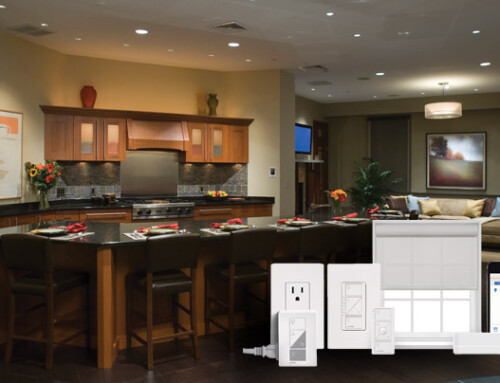Today’s dining rooms reflect consumers’ changing lifestyles. Once used solely for daily dining, this room has become more multipurpose.
 “During the week, we use the dining room as a work zone, for homework, crafts, church work, organizational meetings,” says Dan Blitzer, continuing educator for the American Lighting Association. “On the weekends and special occasions, it becomes a gathering place for parties and meals.”
“During the week, we use the dining room as a work zone, for homework, crafts, church work, organizational meetings,” says Dan Blitzer, continuing educator for the American Lighting Association. “On the weekends and special occasions, it becomes a gathering place for parties and meals.”
The result? Dining rooms must boast multiple lighting options that can go from functional to fashionable in the flick of a switch.
To get the best balance of illumination in the dining room, opt for layers of light. “The most important thing a homeowner should recognize is that a dining room does not look well-lighted if the only light source is a chandelier,” says Blitzer. “A chandelier that is bright enough to illuminate a room will be too bright for comfort when dining. Likewise, if the chandelier’s light is comfortable on the eyes, it will be too dim and look flat.”
When choosing dining room lighting, start with a chandelier in the middle of the room, then work out with accent lights. The chandelier will determine the room’s feeling. Use your imagination. In today’s more eclectic decor, even casual homes can have elegant dining rooms.
“You might find casual wrought iron or brushed steel metal fixtures in the home’s adjacent “great room” and wrought iron with crystal drops or pendants in the dining room, creating a more romantic, softer setting,” Greg Vandia, Vice President Sales and Marketing for New York manufacturer Murray Feiss.” That’s perfectly acceptable.”
When selecting a chandelier, don’t worry about the fixture’s quality of light as much as its beauty and scale. Chandelier choices include everything from those with exposed bulbs to those with large alabaster diffusing bowls. Trends range from simple Mission-inspired models with mica glass to ornate brass filigree with crystal pendants.
“Finish is the most important factor today and it should compliment surrounding furnishings and accessories; not match or contrast,” says Rick Wiedemer, CLC, President of Hinkley Lighting, Inc., a manufacturer in Cleveland, OH. “The finish selected will then determine the material.”
Popular materials include brass, aluminum, wrought iron, other metal combinations, or composite materials.
Crystal chandeliers are one of the most traditional ways to compliment a dining room setting. “Crystal chandeliers work to create an ethereal, magical look — even if they are not turned on,” says Eileen Schonbek Beers of Schonbek Worldwide Lighting, one of the country’s top chandelier manufacturers.
According to Beers, candlepower chandeliers — those without electricity — rate as one of the latest trends in dining room decor. “We have been selling a lot of chandeliers to be used simply as decorative accessories,” says Beers, who saw the trend begin in 2000. “It’s a phenomenon driven by people who want recessed lighting or candles on their table as their light source. Antique chandeliers were not wired for electricity originally, but were used for the way other light played off the crystal.”
Whether you opt to illuminate your chandelier or not, make sure you choose the right size chandelier for your environment. To find the right size chandelier, choose one with a diameter 12” less than width of table, suggests Wiedemer. This assumes the table is sized appropriate for room. The bottom of chandelier should be 30” above table. For ceilings nine feet or higher, consider a two-tier style chandelier to fill the space from the fixture’s top to the ceiling.
“It is better to go bigger than to end up with a chandelier that is too small,” says Beers. “If you are making the investment, you want to make a statement.”
Accent lights, either recessed or tract-mounted, on either side of the chandelier and between the end of the table add a festive sparkle to china, crystal, fruit arrangements. Space them so they are not over the head of diners, but not so close to the chandelier to create shadows. Angle them toward the chandelier to add sparkle to the chandelier and provide down lighting.
The final layer of light should fill in the shadows around the room’s perimeter. Consider recessed lights located in the ceiling toward the corners of the room. Wall washers, recessed or mounted on tracts, can illuminate drapes or paintings. Torchieres and sconces point light toward the ceiling.
Don’t forget to light furniture around the edge of the dining room. “Buffets, hutches or breakfronts can be illuminated internally with low voltage lights on the underside of shelves to light up collections and china,” says Blitzer.
Portable lighting, or table lamps, also plays an important role in the dining room area. “Accent lamps on breakfronts or etageres or two great buffet lamps with unique shades can help create just the right mood for that special meal or occasion when the dining room is being utilized,” says Vandia.
Other options include recessed or tract lighting above buffets or breakfronts. Miniature low voltage pendants suspended three feet above the buffet offer a more contemporary look, while tall, thin candlestick lamps on either end are more traditional.
Top Tips for Lighting Dining Rooms
The American Lighting Association offers the following tips for lighting a delightful dining room.
FIRST STEP: A chandelier in the middle of the room defines the space. Choose that fixture first, then work out with accent lights.
HANGING AROUND: Choose a chandelier with a diameter 12” less than width of table. The bottom of chandelier should be 30” above table.
TALL ORDERS: For ceilings nine feet or higher, consider a two-tier style chandelier to fill the space from the fixture’s top to the ceiling.
DIMMER SHIMMER: Always use a dimmer on dining room lights. “Light becomes warmer as it is dimmed,” says Dan Blitzer, American Lighting Association Continuing Educator.
HOME WORK: For those who use the dining room as a study area, consider bringing in a portable study lamp to brighten up the workspace. “Overhead lighting may work well for general studies, but in depth or close work demands more light,” says Blitzer.
GET SMART: So-called “smart” dimmers, driven by microprocessors offer convenience. “When you have several layers of light, smart dimmers can be set to various ambiences. Press one button for dining, another for lighting up homework, another for party-time.
THE LAYERED LOOK: Use multiple layers of light in the dining room. Chandeliers provide the central focus. Accent lights on either side of the chandelier and at the room’s perimeter brighten things up. Accessory lights on and/or over other furniture pieces fill in the background.
TABLE THIS: Table lamps add a soft, humanizing touch to a dining room. Display them on a buffet or breakfront.
The American Lighting Association is an organization of lighting manufacturers, showrooms, and sales representatives dedicated to providing the public with quality residential lighting. ALA member showrooms feature a broad selection of lighting fixtures, as well as Certified Lighting Consultants and Lighting Specialists who can provide lighting tips, design lighting schemes and help choose fixtures that best suit your lighting needs. Wolberg Lighting Design is proud to be an American Lighting Association member, with lighting experts trained to help you make the best selections for your taste and budget.







